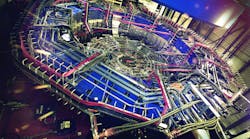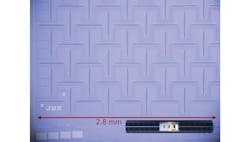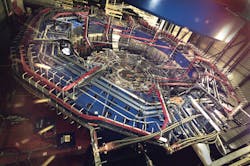As the doors to millimeter-wave sensing and generation have opened, scientists and researchers have begun creatively using this new realm of electromagnetic (EM) radiation to enhance their current experiments and make new ones possible.
Related Articles
- Millimeter-Wave Technology Prepares For A Wealth Of Applications
- Millimeter Waves Extend Wireless Services
- Adapters And Couplers Ride The Millimeter Wave
The imaging of 95/150-GHz radiation for the background imaging of cosmic-extragalactic-polarization (BICEP) projects is among the millimeter-wave technologies making a splash in the hard-science world. Notably, the Relativistic Heavy Ion Collider (RHIC) at Brookhaven National Laboratory also uses millimeter-wave technology for collision accuracy boosts.
Generally, millimeter waves are defined as EM radiation between the tens of gigahertz and hundreds of gigahertz. The cosmos, human bodies, and many other objects naturally radiate this energy. Now, millimeter waves can be generated reliably to enable the latest in high-speed communications.
This file type includes high resolution graphics and schematics when applicable.
Current Applications
Some of the interesting properties of millimeter waves are derived from their relatively small wavelengths compared to current telecommunications technology, although their wavelengths are still large compared to light waves. Millimeter waves, then, can take advantage of the recent capabilities of high-frequency semiconductors without having to depend on photonic technology.
For example, an antenna array that receives or transmits millimeter waves could be built on an integrated circuit (IC) with tens to hundreds of elements on a single die. This approach allows phased-array antenna techniques to work in conjunction with communication technology methods, increasing signal integrity to produce high-resolution imagers.
The resulting millimeter-wave imagers are safe to use around humans while penetrating light layers of clothing. For screening large groups or rapidly screening passengers in an airport, these imagers give security personnel a rapid and non-intrusive method to identify threats. With slight modifications and sophisticated knowledge of cosmic physics, these sensors can be adapted to measure radiation that has theoretically been polarized from gravity effects during the Big Bang.
The BICEP, BICEP2, and BICEP3 projects use arrays of millimeter-wave antennas and sensors to detect the degree-scale, B-mode polarization induced by background gravitational wave effects. The BICEP experiments aim to predict and verify the polarization of the B-mode waves, which may indicate aspects of the cosmic inflation theory. These devices also could enable a rudimentary understanding of the physical process for inflation. The sensors comprise planar arrays of dual-polarization, antenna-coupled, transition-edge-sensor (TES) bolometers operating between 90 and 220 GHz. The dual-polarization characteristics enable the detection of both A and B mode polarizations.
For the BICEP2, each 150-GHz sensor uses an array of 64 polarimeters (or 128 TES detectors). Every sensor is fabricated using a four-inch silicon wafer process (Fig. 1). To capture both A and B linear polarizations, the polarimeter units use a pair of planar, co-locating, orthogonal phased-array antennas as well as a microstrip summing network, microstrip bandpass filters, and a pair of TES bolometers.
Each polarization has an independent microstrip summing network and two sets of orthogonal slots, which allow it to isolate different polarizations (Fig. 2). This isolation is achieved by forming a beam using beam collimation and then coherently combining the signals from the sub-antennas with a superconducting niobium microstrip summing network.
Next, the signals are fed through a microstrip bandpass filter with a bandwidth that is marginally narrower than that of the antennas. The signals leave the bandpass filter and travel through the superconducting strip, which terminates in a meandering resistive microstrip. Thermal energy from the radiation is detected using a thermally isolated TES bolometer on the silicon-nitride (SiN) island (Fig. 3). A field of 256 dual-polarization elements is constructed as a focal plane of four arrays.
The detector wafers are stacked with a quartz anti-reflection wafer and mounted on a gold-plated copper plate. Gold wire bonds are used to electrically connect the detector wafer and a printed-circuit board (PCB) with signal-refinement electronics. The signals from the detectors are delivered through the gold wire bonds to a 33-element, superconducting-quantum-interference-device (SQUID) multiplexer (MUX) chip from the National Institute of Standards and Technology (NIST).
These chips are maintained at the same temperature as the detector arrays. They use a NIST Nyquist-inductor (NYQ) chip to filter out high-frequency noise. In contrast, low-frequency noise is removed from the system using correlation techniques and data from several “dark” SQUID channels with severed microstrip connections to the antennas.
BICEP2 uses a science-grade focal-plane mount deployed at the Amundsen-Scott South Pole Station for optimal optical performance. Once the data from the multi-year-long experiment was processed, it revealed the most sensitive polarization maps of cosmic-microwave-background (CMB) radiation. Aiming for sensitivity increases and higher-resolution images, the scientific groups advancing the project are developing higher-grade detector arrays and larger array concepts.
For example, the Keck Array project uses five separate mounts with multiple imagers embedded in each mount while running two 100-GHz imagers. To boost sensitivity and resolution, the BICEP3 project promises to include 2056 detector arrays at 100 GHz with a larger aperture and 10 times BICEP2’s optical throughput. Another way to study the underlying dynamics of the universe is to attempt to generate the conditions of the early cosmos using high-energy particle collisions and to learn from the ensuing fireworks.
Spinning Up High-Energy Particle Physics
One technique for understanding the nature and history of our universe is to smash high-energy particles against each other while they are traveling at near-relativistic speeds. These collisions, which cause particle sundering, could potentially reveal the details of quantum particle interactions.
Of particular interest to Brookhaven National Laboratory are quarks—the components within sub-atomic particles. The scientists at Brookhaven use the RHIC to accelerate sub-atomic particles, such as neutrons and protons, to 99.995% the speed of light (Fig. 4).
To achieve the maximum number of collisions, the RHIC needs to generate a compact cloud of positively charged particles. It uses a method known as stochastic cooling that helps to increase the rate of collisions by three to five times. Stochastic cooling produces closely spaced bunches of around 100 billion particles.
To ensure that these bunches collide, electromagnetic (EM) fields are used to control and direct the particles in two opposed and independent beam pipes that intersect in four separate locations. Detailed data is needed to decipher the physics of the collisions. As a result, testing occurs tens of thousands of times per second for nearly half the year.
To coordinate so many collisions at such a rate, sophisticated calibration and tracking mechanisms are needed. Electronics are used to sense beam errors and establish timely beam correction with the beam-correcting electronics via millimeter-wave control signals.
To ensure that the signals can quickly report errors and provide correction details, the millimeter-wave sensors are configured along a shortcut path to help the signals outpace the accelerated particles. The millimeter-wave device used in this process was a custom-created system made by HXI, a subsidiary of Renaissance Technology.
HXI delivered the custom parts in only a few months by utilizing current 70-GHz light-licensed technology. By converting it to analog, HXI broadened the bandwidth by 5 to 9 GHz. Converting a digital communications wireless link to an analog link was one of the challenges in implementing the new detector. The technology required significant modifications, and most of the digital communications electronics was removed.
“The difficulty was with the upconverting/downconverting and making sure that the radio matched the dynamic range of the RHIC systems,” said Earle Stewart, HXI’s business development manager.
The older digital radios had free-running local oscillators (LOs). In contrast, the LOs in the analog radio are phase-locked for better phase stability and much higher dynamic range (almost 40 dB). To reap the maximum benefit from the link system, the RHIC lab used two sets of radio links positioned in different parts of the RHIC.
As a result, the analog millimeter-wave link can communicate rapidly between the beam sensors and the beam correction technology—a distance of approximately 700 m. In doing so, it can provide a highly enhanced collision experience. Using millimeter waves in this project instead of other control-signal-relay technology, such as lasers, drastically reduced the cost of implementing a correction system. In theory, the millimeter-wave control device used to enhance the stochastic cooling mechanism also was able to increase the heavy ion collision luminosity by a factor of two.
References
“Antenna-coupled TES Bolometer Arrays for BICEP2/Keck and Spider,” A. Orlando, et al., http://authors.library.caltech.edu/22893/1/Orlando2010p12895Adaptive_Optics_Systems_Pts_1-3.pdf
BICEP2 2014 Results Release, http://bicepkeck.org/
“Time Division SQUID Multiplexers,” Kent D. Irwin and Mark Halpern, http://cmbpol.uchicago.edu/workshops/technology2008/depot/tdm_white_paper_v1.pdf





